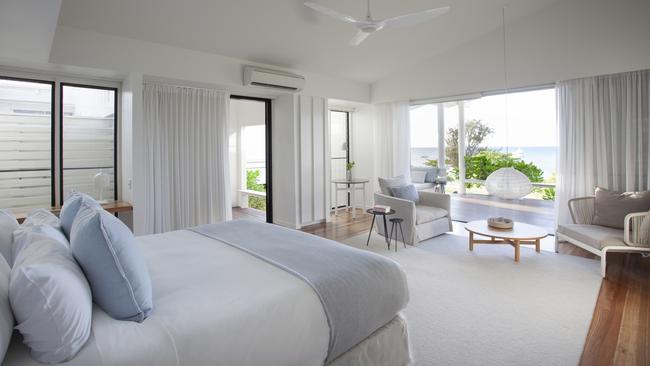Lizard Island Resort teams up with vital reef preservation project
This resort in Far North Queensland is at the heart of a citizen-science project informing conservation efforts for the Great Reef Census.

A sense of excitement builds as the 12-seater airplane descends over the Coral Sea and a vision appears through the pilot’s windscreen: a mountainous island, fringed with white beaches and headlands, its peak wreathed with wisps of cloud. For the past hour we’ve been flying north from Cairns, over the Great Barrier Reef, and I’ve realised the singular name is misleading: there are thousands of individual reefs, scattered like Rorschach splats of turquoise ink on a canvas of deep indigo. I’ve had my nose pressed up against the side window the whole time, taking in the view below. But now my attention is focused forward, over the pilot’s shoulder and through his windscreen, at that island. Specifically, at the runway nestled between two scrubby hills. It looks, um, a bit short, that runway. My sweaty hands grip the seat. The pilot’s hands work the controls with deft movements as he lines up our approach, swooping low over the lagoon on the island’s south side then bumping down on to the tarmac and decelerating hard amid a crescendo of noise and vibration from the engine. He taxies to a halt, opens his side window to let in a blast of hot, humid air, and turns around to us with a wide grin. “Welcome to Lizard Island,” he says.
Exactly 252 years, two months and 16 days after Captain James Cook rowed ashore here – he wanted to climb the island’s mountain, to spot a way through the maze of reefs – our own arrival is rather more luxurious. Chilled damp hand-towels are proffered on silver tongs at the Lizard Island Resort’s reception, then we are wafted onwards for a glass of champagne in its Salt Water restaurant, a drop-dead-gorgeous space with a 50m-long, curving open frontage offering panoramic views over Anchor Bay, where gleaming white yachts lie moored.

The swooning continues when I’m shown to my digs, a suite decorated in a palette of creams and greys, its French doors opening to a courtyard balcony with a daybed overlooking the beach. It’s spotless, stylish, moneyed. To be honest, reader, this is all a culture shock: I live in Sydney, in a house with two boys and a labrador who share a casual disregard for the niceties of personal space and hygiene, and I’ve suddenly been deposited into what looks like the set of a Duran Duran video. I feel a strange urge to loll around in a crumpled linen suit, barefoot, perhaps with the sleeves rolled up to my elbows, taking soft-focus Insta selfies. But first, a dip.

Wearing a black head-to-toe “stinger suit” (this being box jellyfish season), fins, mask and snorkel, and suddenly feeling nothing at all like Simon Le Bon, I swim from the beach straight into an aquatic wonderland. There are colourful hard corals shaped like brains and plates and antlers, and soft corals wafting gently in the current. There are giant clams, some as wide as my outstretched arms, with lurid purple, crinkle-cut maws. Heaps of dazzling fish, too: fusiliers and damsels, sweetlips – named for their puckered, kissy-kissy mouths – and angelfish.

The constant crackling sound underwater comes from the ubiquitous parrotfish, which chew off bits of coral, crunch it up and excrete it as sand. (Fun fact: these dazzling beaches were created largely by parrotfish poo). A green sea turtle gives me the side-eye as it glides past with a flap of its front flippers. And this is all within a stone’s throw of my suite. I’m getting really excited about tomorrow, when I’ll be snorkelling on some far-flung reefs for the Great Reef Census, a brilliant citizen-science project that has partnered with the Lizard Island Resort.
Now, though, it’s beer o’clock, so I dry off and head to the Marlin Bar, a laid-back venue with live music. There are some salty types in tonight: boaties taking part in a local game-fishing tournament. The big ’uns are biting, and tales abound. Leon, the resort’s amiable general manager, shows me a picture of a 350kg black marlin he caught a few weeks ago in a deep channel between two nearby reefs. Someone else, he adds, hooked an even bigger marlin – perhaps 500kg – but reeled in only its head, the rest of it having been devoured by sharks. Another bloke in the bar hears this and claps me on the shoulder with an evil grin. “Enjoy the snorkelling tomorrow mate,” he says.

The next morning we board Pisces – the resort’s 17m, gyro-stabilised, air-conditioned yacht – and motor east for an hour to two outer reefs, Wedge and No-Name. Our task is to snorkel along these reefs taking photos, then upload them to the Census website (greatreefcensus.org) with our co-ordinates; all along the Great Barrier Reef, until the end of January, volunteers will be doing the same. Other “citizen scientists”, aided by AI, will sit at their laptops analysing the images. The Census will provide a large-scale snapshot of the health of the Great Barrier Reef – and a vital dataset for informing conservation efforts.

The morning passes in a blur of activity: at half a dozen spots around Wedge and No-Name we jump off the back of Pisces and fin along the reef edge, which drops away vertically below us. It feels like flying. We snap photographs continuously, marvelling at the coral – plenty of it still appears to be in good nick – and the big fish: schools of Spanish mackerel blasting past us like silvery torpedoes; bumphead parrotfish, a metre long, grazing on the coral. There are sharks, too: not the sort of monsters that’ll barrel up from the deep ocean to strip a half-tonne marlin, thankfully, but harmless reef sharks – whitetips and greys – slinking gracefully among the corals.

In the evening, over dinner in Salt Water (where we dine on grilled cuts of a wahoo “caught yesterday by our chef Kyle”, the waiter tells us), we debrief with Andy Ridley, CEO of Citizens of the Great Barrier Reef, which is running the Census. “The beauty of this project is that you don’t need to be a marine biologist to take part,” he says. “Anyone can join in and contribute to this vital conservation work, either in the water or analysing images on their computer. It’s all about harnessing the power of the crowd.”
The next morning, my final day, I’m up at 5.30am to climb Lizard Island’s peak with Leon, the resort’s manager. We cross a boardwalk over some mangroves – a sign warns of a resident saltwater croc, but “he’s only small, and doesn’t bother anyone”, Leon says – then begin the hour-long climb. It’s hot work, even at this hour. Halfway up, Leon points out The House, an ultra-luxe option (from $16,000 per night) set on its own headland; it opened in July and the first guests were Katy Perry and Orlando Bloom, who stayed for a month.

Finally we reach Cook’s Look, the top of the mountain at 359m above sea level. Yorkshire Jim was 41 years old when he stood on this spot on August 12, 1770, surveying the surrounding waters. He spent a couple of days on Lizard Island, and was impressed by what he found here - ample fresh water, wood for fuel, and abundant seafood in the surrounding waters; he noted that “there is, perhaps, not a better place on the whole Coast for a Ship to refresh at than this Island”.
Cook writes in his journal of his “mortification” at the view from the mountain top: there were dangerous reefs and shoals all around. (And bear in mind he had good reason to be nervous, having almost lost the Endeavour two months previously when they struck a reef and had to make a life-or-death dash to shore, beaching the ship for repairs where Cooktown now stands.) Still, he spotted a gap to the northeast that offered passage to the open ocean, and two days later he skilfully threaded the Endeavour through that gap, now known as Cook’s Passage. After three fraught months of navigating north through the Great Barrier Reef, they were at last free.
In a curious twist, a few days later Cook steered the ship back inside the barrier reef. He records in his journal that he did so because it was leaking alarmingly in the heavy swells of the open ocean. But Leon has another theory. He reckons old Cookie just wanted one final look at Lizard Island, this special little place, before he sailed away forever. And I reckon he might be right.


To join the conversation, please log in. Don't have an account? Register
Join the conversation, you are commenting as Logout